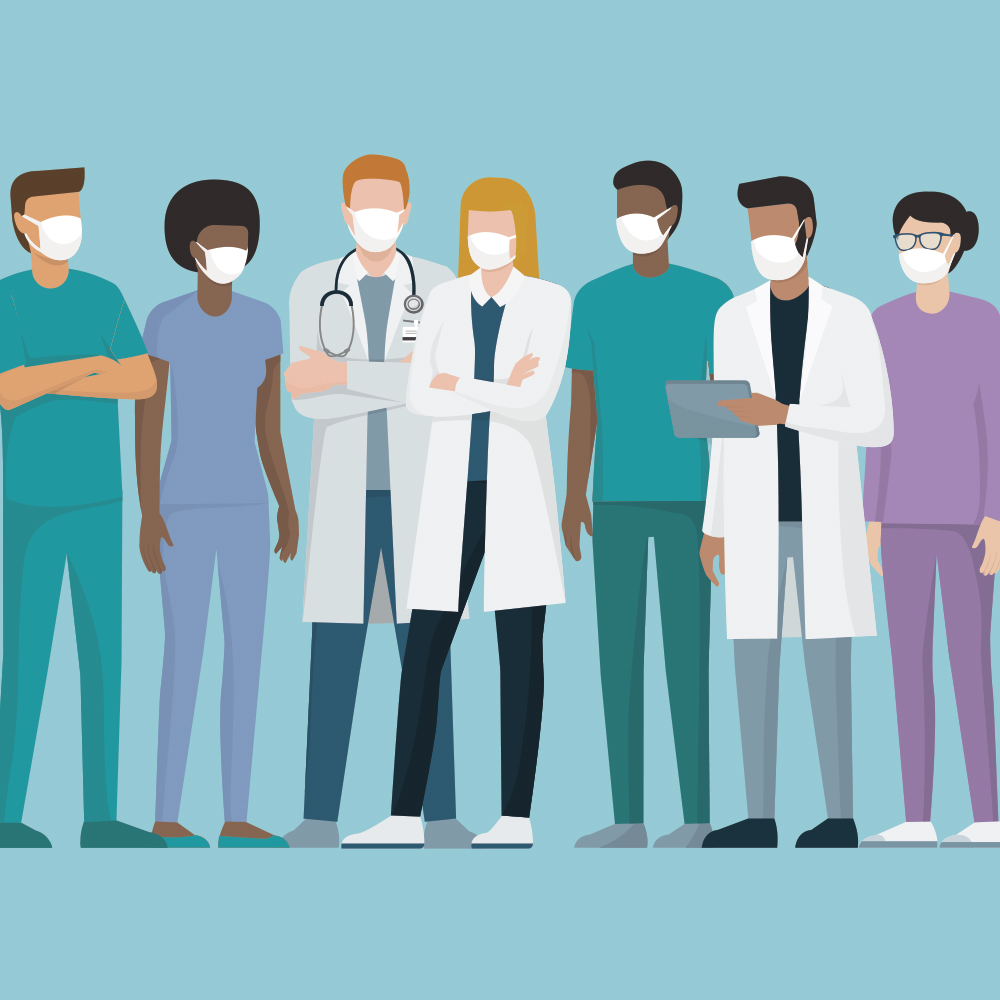The Emergence of a New Healthcare Crisis: Patients Avoiding Hospitals and Doctors’ Offices
By Annice Wyatt
The outcome of the coronavirus (COVID-19) pandemic has brought immense change to our world, especially in the healthcare system. Starting in April, many hospitals and physician offices postponed elective procedures and in-person appointments to ensure the safety of their patients and staff. This also helped to provide enough space and personal protective equipment (PPE) to treat COVID-19 patients.
As a result, a large number of these practices have begun to implement telehealth or strengthen their existing telemedicine programs. In the past few months, telehealth has seen tremendous success for providing a safe and convenient alternative to coming directly into the office. However, while telehealth services and home visits can “supplement some hospital visits, other in-person appointments cannot be replaced” [1], and quite a few hospitals and offices in the U.S. are noticing a significant drop in the number of patients visits.
If access to healthcare continues to be a financial challenge for Americans due to the pandemic, or if the fear of contracting the virus continues to restrain patients from seeking treatment, the long-term health of the U.S. population could suffer tremendously.
How Healthcare Systems Have Been Impacted by COVID-19
Starting in March, the threat of the coronavirus started dominating headlines in the U.S. The early spread of the virus was unprecedented and uncontrollable. There was no gradual shift in our daily lives. Instead, many people had to quickly adjust and adapt to a new way of living. For instance, the stay-at-home orders and social distancing practices led many people to self-quarantine in their homes.
In this time, a new crisis is beginning to emerge: patients are avoiding emergency rooms and physician offices. Many healthcare facilities have noticed a clear decrease in the number of heart attacks and strokes presenting in U.S. hospitals [3].
There is also a financial cause, as many Americans have lost their jobs (36 million in the last two months [2]) and insurance. As a result, several individuals are faced with the challenge of affording access to healthcare.
Clearly, there has not been a sudden decline in these medical conditions among the public. Rather, patients are not admitting themselves into hospitals or making visits with their doctors when symptoms do arise. As a result, many of America’s primary care practices are struggling financially to remain operational [4].
New data collected from research at Harvard University indicates that outpatient visits have dropped nearly 60% from the first week of March and that the numbers are staying low [5]:
Several specialties have been impacted:
- Ophthalmologist appointments are down 79%.
- Dermatologist appointments are down 73%.
- Urology appointments are down 63%.
- Cardiology appointments are down 61%.
- Pediatric appointments are down more than 60%.
- Adult primary-care appointments are down 49%.
- OB-GYN practices are seeing about half as many patients as they typically would.
Why Patients Are Avoiding Hospitals and Physician Offices During a Global Pandemic
As the data shows, the coronavirus pandemic has impacted and will continue impacting our economy. In addition, it has also changed our psychology in how we choose to interact with one another. Even with many states beginning to reopen, recent headlines suggest that people are simply not ready to socially engage. In several instances, many Americans are, therefore, delaying and/or avoiding necessary treatment and care from their healthcare providers.
According to the U.S. Centers for Disease Control and Prevention, someone in the United States has a heart attack about every 40 seconds [6]. And it is not just data suggesting that Americans are not coming in for treatment or care, but healthcare facilities themselves are seeing this effect in their operations. Dr. William Jaquiz, the president of the American College of Emergency Physicians, expressed concern about the decrease in patients utilizing healthcare. He says that he has not “seen anything like it, ever. We anticipated, actually, higher volumes.” Similarly, Dr. David Tashman, the medical director of the emergency room at USC Verdugo Hills Hospital in Glendale, California, expressed his disbelief: “It was very scary because it was so quiet. We normally see 100 patients a day, and then, you know, overnight, we were down to 30 or 40.” [7]
In the midst of the pandemic, many providers have further integrated telehealth into their practices. The use of telehealth, though, is far from a recent development, but the coronavirus pandemic increased the demand for telehealth in healthcare systems. Although these virtual visits and remote monitoring may be here to stay, in-person visits remain fundamental for patient health.
The reason behind the decline in patient visits to emergency rooms and physician offices has several layers. For example, approximately one in three Americans are delaying medical care as they cope with financial losses and stress caused by COVID-19 [8]. The numbers of unemployment claims are staggering. In early May, the ADP National Employment report showed more than 20 million jobs were lost in the United States in the month of April, alone. This translates to one in five American workers having filed for unemployment benefits since mid-March [9].
However, there are many Americans who are simply avoiding treatment out of fear of contracting the COVID-19 virus. In a recent Morning Consult poll conducted between April 29–30 with among 2,201 U.S. adult participants, 62% said that it is unlikely that they would visit a hospital during the pandemic for reasons unrelated to the COVID-19 [10].
If a patient is experiencing symptoms of a heart attack or stroke — such as weakness on one side of the body, sudden confusion or trouble speaking, chest pain, shortness of breath, nausea or vomiting — it is vital to seek medical attention immediately.
In addition, if a patient is pregnant, diabetic, has a history of hypertension or chronic disease, is undergoing cancer treatment or has recently been diagnosed with cancer, and/or spots a mole that is changing in shape, size, and color, it is important that that patient continues actively seeing and speaking with their providers. Avoiding treatment for a medical condition, although it may seem minor, can be extremely dangerous and even life-threatening.
Patients must also understand their feelings and fears are valid. During the early developments of the pandemic, hospitals, and other healthcare providers delayed their elective procedures to “make room” for COVID-19 [11]. Visiting a physician for a routine check-up, receiving cancer treatments, consulting with a urologist about treatment for kidney stones, and going into surgery for a broken bone, all create a sense of security. However, as the coronavirus pandemic progressed around the world, the security many once enjoyed seemed to fade away as more and more COVID-19 patients were filling up hospitals and offices were shutting down.
Andrea Gleason, 72 years old, started feeling abnormal pains in her chest but avoided the hospital because of her fear of contracting COVID-19 and of “burdening doctors.” Mrs. Gleason expressed that she “pictured the New York situation with lots of people in the hallways and I didn’t need to be there.” Although, at first, Mrs. Gleason did not admit herself in the hospital, she finally went after the pain became intolerable and the doctors found that her artery was almost entirely blocked and swiftly fitted a stent. If Mrs. Gleason had delayed going to the hospital for one more day, the cardiologist explained that her condition would have quickly progressed to a heart attack that could have killed her [12]. Andrea’s story not only demonstrates a patient listening to their body, but in addition, confirms that hospitals and healthcare facilities are still the best and safest places to receive treatment.
Next Steps for Patients: Now and in the Future
As the infection curve begins to plateau in the United States, many healthcare facilities are preparing to resume elective procedures by establishing extreme precautions to ensure the safety of their patients and staff.
During the pandemic and especially post-coronavirus, everyone should continue to be proactive about their health. To do so, it is important for patients to understand what their resources are and make risk assessments in a rational way:
- Does the provider offer telehealth?
- No matter the severity, patients should continue speaking with their providers.
- Patients should never hesitate to ask their provider questions.
- Monitor communications sent out by providers about the COVID-19 and their plans for ongoing treatment, such as through text messages, e-newsletters, and/or information outlined on the website.
- Continue following best social distancing practices even in public settings.
- Inquire about financial aid.
As states continue to reopen and practices resume elective procedures and operations, it is important for patients to continue managing their health:
- If a patient is experiencing symptoms that require immediate attention, they should seek help immediately. Call 9-1-1 or visit the emergency room. By skipping out on care or treatment, that patient may be putting themselves at further risk of complications if care is avoided.
- If a patient is unable to visit their provider for an in-person appointment, they should find out if their provider offers telehealth. If that telehealth appointment is made and the provider recommends that the patient have an in-person follow up, they should not avoid that care.
- Remember, providers make decisions based on the health and safety of their patients. However, if a patient is concerned about the safety of the physician office and is curious about what safety precautions are being made, speak with that provider or hospital and ask those appropriate questions.
If Americans continue to avoid care and treatment, our country could potentially find itself in another healthcare crisis unrelated to COVID-19. As specified by Dania Palanker, an assistant research professor for the Center of Health Insurance Reforms at Georgetown’s Health Policy Institute, “Is maintaining your health urgent care? Not something we usually put in the box of ‘urgent’, but if we don’t take care of it, it’s going to get urgent or emergent.” [13]
References
- Kaufman, E. (2020, April 5). As hospitals focus on coronavirus, patients with other illnesses wait in fear. Retrieved from https://www.cnn.com/2020/04/04/health/sick-without-covid-wellness/index.html
- Rushe, D., Aratani, L., & Holpuch, A. (2020, May 14). 36m Americans now unemployed as another 3m file for benefits. Retrieved from https://www.theguardian.com/business/2020/may/14/unemployment-us-data-coronavirus
- Howard, J. (2020, April 22). Coronavirus scares too many sick people away from hospitals, doctors say. Retrieved from https://www.cnn.com/2020/04/22/health/coronavirus-hospitals-heart-health-statement/index.html
- Scott, D. (2020, April 27). Coronavirus has created a crisis for primary care doctors and their patients. Retrieved from https://www.vox.com/2020/4/27/21231528/coronavirus-covid-19-primary-care-doctors-crisis
- Scott, D. (2020, April 27). Coronavirus has created a crisis for primary care doctors and their patients. Retrieved from https://www.vox.com/2020/4/27/21231528/coronavirus-covid-19-primary-care-doctors-crisis
- Howard, J. (2020, April 22). Coronavirus scares too many sick people away from hospitals, doctors say. Retrieved from https://www.cnn.com/2020/04/22/health/coronavirus-hospitals-heart-health-statement/index.html
- Stone, S., & Yu, Elly. (2020, May 8). Empty ERs Worry Doctors as Heart Attack and Stroke Patients Delay Care. Retrieved from https://www.usnews.com/news/healthiest-communities/articles/2020-05-08/empty-emergency-rooms-worry-doctors-as-heart-attack-stroke-patients-delay-care
- Kacik, A. (2020, April 28). Nearly a third of Americans put off healthcare during COVID-19. Retrieved from https://www.modernhealthcare.com/patient-care/nearly-third-americans-have-put-healthcare-during-covid-19?utm_source=modern-healthcare-am-wednesday&utm_
- Tappe, A. (2020, May 7). 1 in 5 American workers has filed for unemployment benefits since mid-March. Retrieved from https://www.cnn.com/2020/05/07/economy/unemployment-benefits-coronavirus/index.html
- Yerman, B. (2020, May 4). Amid Pandemic, Public Wary of Seeking Non-Coronavirus Care From Providers. Retrieved from https://morningconsult.com/2020/05/04/coronavirus-health-care-providers-polling/?mkt_tok=eyJpIjoiWkRFd05USmtaVFkyTWpabCIsInQiOiJVZWlETkYreVJXOHRINTRIcEhhRmx2bm5LRm5vdDNlOW9TN3d5VkcxdkIyeHBwNDJEYWV1R0ZidGRIYmNkNklKNFFESVNudUMwTjEwVGhjUkJWSk9xZllteDBlWWhYM1VrSzFWTDlHV1I0VmplYkVNTjR5RzJ1elVEc3NOSFFxRyJ9
- Kacik, A. (2020, April 28). Nearly a third of Americans put off healthcare during COVID-19. Retrieved from https://www.modernhealthcare.com/patient-care/nearly-third-americans-have-put-healthcare-during-covid-19?utm_source=modern-healthcare-am-wednesday&utm_
- Roland, D., Lovett, I., & Toy, S. (2020, May 14). Doctors Fret as Coronavirus Keeps Heart, Stroke Patients Away From ER. Retrieved from https://www.wsj.com/articles/doctors-fret-over-lower-er-attendance-during-pandemic-11589454002
- Scott, D. (2020, April 27). Coronavirus has created a crisis for primary care doctors and their patients. Retrieved from https://www.vox.com/2020/4/27/21231528/coronavirus-covid-19-primary-care-doctors-crisis


